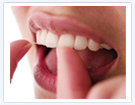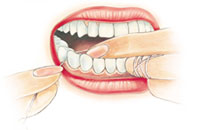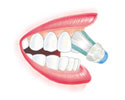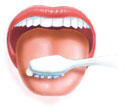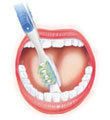|
Flossing & Brushing To have good dental health, you need a mix of personal dental care, and the care of your dentist.
Flossing Flossing removes plaque and bacteria that you cannot reach with your toothbrush. If you don't floss, you are missing more than one-third of your tooth surface. Plaque is the main cause of gum disease. It is an invisible bacterial film that develops on your teeth every day. Within 24 to 36 hours, plaque hardens into tartar (also called calculus), which can only be removed by professional cleaning. Floss at least once a day, and plaque never gets the chance to harden into tartar. Getting into the habit of daily flossing is easier when you floss while doing something else like watching TV or listening to music, for example. How to floss your teeth Step 1
Wrap it around your index and middle fingers, leaving about two inches between your hands.
Step 2
Step 3
Step 4
Flossing Problems and Solutions Gums sometimes bleed when you first begin to floss. Bleeding usually stops after a few days. If bleeding does not stop, see your dentist. Floss can shred if you snag it on an old filling or on the ragged edge of a tooth. Try another type of floss or dental tape. Ask your dentist for advice. If your floss still shreds, see your dentist.
Brushing Regular, thorough brushing is a very important step in preventing tooth decay and gum disease. Brushing removes the bacteria that promote tooth decay and the plaque that can cause gum disease. Ideally, you should brush after every meal, because the bacterial attack on teeth begins minutes after eating. At the very least, brush once a day and always before you go to bed. Brushing your teeth isn't complicated, but there is a right and a wrong way. How to brush your teeth Step 1
Step 2
Step 3
Step 4
Step 5 |
|
|

